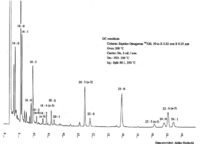LBF18206SC05: Difference between revisions
No edit summary |
No edit summary |
||
| Line 16: | Line 16: | ||
|Source=Constituent of the essential fatty acids (vitamin F) and of various microorganisms; oils of cottonseed, soybean, peanut, corn, sunflower and poppy seed. | |Source=Constituent of the essential fatty acids (vitamin F) and of various microorganisms; oils of cottonseed, soybean, peanut, corn, sunflower and poppy seed. | ||
|Chemical Synthesis= | |Chemical Synthesis= | ||
|Metabolism=Linoleic acid (18:2n-6) is synthesized from oleic acid (18:1n-9) by desaturation of <FONT FACE="Symbol">D</FONT>12-desaturase, and <FONT FACE="Symbol">a</FONT>-linolenic acid (18:3n-3) is formed from linoleic acid by desaturation reaction of <FONT FACE="Symbol">D</FONT>15-desaturase. Since both <FONT FACE="Symbol">D</FONT>12- and 15-desaturases are present in plant cells but not in animal cells, linoleic and <FONT FACE="Symbol">a</FONT>-linolenic acid are not biosynthesized in animal cells in vivo. When ingested by animals, linoleic acid is desaturated, elongated to form <FONT FACE="Symbol">g</FONT>-linolenic acid (18:3n-6), dihomo-<FONT FACE="Symbol">g</FONT>-linolenic acid (20:3n-6), arachidonic acid (20:4n-6) and adrenic acid (22:4n-6). Docosapentaenoic acid (22:5n-6) is synthesized from adrenic acid in significant amounts only under conditions of prolonged n-3 fatty acid deficiency., No interconversion between the n-6 and n-3 series in mammals. Nutritionally, it is important to note that different foods contain different proportions of n-6/n-3 and therefore the n-6/n-3 ratio in tissue lipids change significantly depending on the choice of foods.[[Reference:Okuyama_H:Kobayashi_T:Watanabe_S:,Prog. Lipid Res.,1996,35,409|{{RelationTable/GetFirstAuthor|Reference:Okuyama_H:Kobayashi_T:Watanabe_S:,Prog. Lipid Res.,1996,35,409}}]] | |Metabolism=Linoleic acid (18:2n-6) is synthesized from oleic acid (18:1n-9) by desaturation of <FONT FACE="Symbol">D</FONT>12-desaturase, and <FONT FACE="Symbol">a</FONT>-linolenic acid (18:3n-3) is formed from linoleic acid by desaturation reaction of <FONT FACE="Symbol">D</FONT>15-desaturase. Since both <FONT FACE="Symbol">D</FONT>12- and 15-desaturases are present in plant cells but not in animal cells, linoleic and <FONT FACE="Symbol">a</FONT>-linolenic acid are not biosynthesized in animal cells in vivo. When ingested by animals, linoleic acid is desaturated, elongated to form <FONT FACE="Symbol">g</FONT>-linolenic acid (18:3n-6), dihomo-<FONT FACE="Symbol">g</FONT>-linolenic acid (20:3n-6), arachidonic acid (20:4n-6) and adrenic acid (22:4n-6). Docosapentaenoic acid (22:5n-6) is synthesized from adrenic acid in significant amounts only under conditions of prolonged n-3 fatty acid deficiency., No interconversion between the n-6 and n-3 series in mammals. Nutritionally, it is important to note that different foods contain different proportions of n-6/n-3 and therefore the n-6/n-3 ratio in tissue lipids change significantly depending on the choice of foods.[[Reference:Okuyama_H:Kobayashi_T:Watanabe_S:,Prog. Lipid Res.,1996,35,409|{{RelationTable/GetFirstAuthor|Reference:Okuyama_H:Kobayashi_T:Watanabe_S:,Prog. Lipid Res.,1996,35,409}}]] Although plants synthesize and store linoleic acid and <FONT FACE="Symbol">a</FONT>-linolenic acid as well as saturated and monounsaturated fatty acids in grains, the proportions of these fatty acids in different vegetable oils differ greatly. Safflower and sunflower oil contain high levels of linoleate, while perilla and linseed oil are rich in <FONT FACE="Symbol">a</FONT>-linolenic acid. | ||
}} | }} | ||
{{Lipid/Footer}} | {{Lipid/Footer}} | ||
Revision as of 20:55, 25 November 2009
| LipidBank Top (トップ) |
Fatty acid (脂肪酸) |
Glycerolipid (グリセロ脂質) |
Sphingolipid (スフィンゴ脂質) |
Journals (雑誌一覧) |
How to edit (ページの書き方) |
| IDs and Links | |
|---|---|
| LipidBank | DFA0159 |
| LipidMaps | LMFA01030120 |
| CAS | |
| KEGG | {{{KEGG}}} |
| KNApSAcK | {{{KNApSAcK}}} |
| mol | LBF18206SC05 |
| Linoleic acid | |
|---|---|

| |
| Structural Information | |
| cis-9, cis-12-Octadecadienoic acid | |
| |
| Formula | C18H32O2 |
| Exact Mass | 280.240230268 |
| Average Mass | 280.44548000000003 |
| SMILES | CCCCCC=CCC=CCCCCCCCC(O)=O |
| Physicochemical Information | |
| -5°C | |
| 229°C to 230°C at 16mmHg | |
| dX420 0.9031 | |
| 1.4711 at 20°C | |
| soluble in acetone, alcohol, ether and petroleum ether. Matthews_NL et al. NicolaidesNet al. | |
| Constituent of the essential fatty acids (vitamin F) and of various microorganisms; oils of cottonseed, soybean, peanut, corn, sunflower and poppy seed. | |
| Linoleic acid (18:2n-6) is synthesized from oleic acid (18:1n-9) by desaturation of D12-desaturase, and a-linolenic acid (18:3n-3) is formed from linoleic acid by desaturation reaction of D15-desaturase. Since both D12- and 15-desaturases are present in plant cells but not in animal cells, linoleic and a-linolenic acid are not biosynthesized in animal cells in vivo. When ingested by animals, linoleic acid is desaturated, elongated to form g-linolenic acid (18:3n-6), dihomo-g-linolenic acid (20:3n-6), arachidonic acid (20:4n-6) and adrenic acid (22:4n-6). Docosapentaenoic acid (22:5n-6) is synthesized from adrenic acid in significant amounts only under conditions of prolonged n-3 fatty acid deficiency., No interconversion between the n-6 and n-3 series in mammals. Nutritionally, it is important to note that different foods contain different proportions of n-6/n-3 and therefore the n-6/n-3 ratio in tissue lipids change significantly depending on the choice of foods. Okuyama_H et al. Although plants synthesize and store linoleic acid and a-linolenic acid as well as saturated and monounsaturated fatty acids in grains, the proportions of these fatty acids in different vegetable oils differ greatly. Safflower and sunflower oil contain high levels of linoleate, while perilla and linseed oil are rich in a-linolenic acid. | |
| Spectral Information | |
| Mass Spectra | |
| UV Spectra | |
| IR Spectra | |
| NMR Spectra | |
| Other Spectra | |
| Chromatograms | Gas liquid chromatogram  (provided by Dr. Akiko Horiuchi). |
| Reported Metabolites, References | |||||||||||||||||||||||||
|---|---|---|---|---|---|---|---|---|---|---|---|---|---|---|---|---|---|---|---|---|---|---|---|---|---|
|